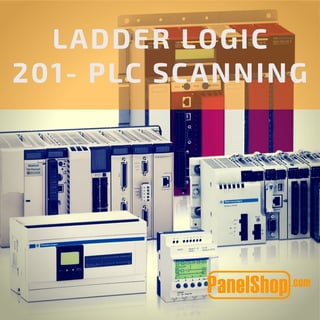 Ladder Logic 201: PLC Scanning
Ladder Logic 201: PLC Scanning
In the beginning of this series of articles, you were introduced to the basics of the programming language ladder logic. With such fundamentals under the belt, it is time to move on to some higher level aspects of this tool, so you can see why it is so widely used in the manufacturing industry today.
The Importance of Scanning
Scanning is a core concept of programming in ladder because most of its applications will involve a programmable logic controller (PLC), which is itself an integral part of the industry. Understanding how scanning works in a PLC is therefore a very important lesson, as it lays the foundation for an understanding of the computation methods lying behind every electronically controlled device on the manufacturing floor. Without this unique approach to programming, the industry would be at a loss.
So what is PLC Scanning?
Almost all PLCs worldwide handle scanning in the same way, with a constant and lighting fast repetition of three basic steps: Input, Execute, and Output.
- Input: In this stage, the PLC takes a snapshot of the inputs by looking at each one and determining if it is ON or OFF and saving that information in a data table for use in the next step.
- Execute: Here, the PLC gets its business done by executing the ladder logic it has been given one instruction at a time using only the memory copy of the inputs it collected just a split second ago.
- Output: When the PLC finishes executing code, it updates the status of the outputs based on which inputs were ON during the first step and the results of executing a program during the second step.
Applications Using PLC Scanning
The PLC can be used in departments of any developed industry, like the chemical industry, automotive industry, steel industry, or the manufacturing industry. And based on the development of all these fields and applications, the scope of the PLC’s computational scanning continues to increase dramatically.
For example, in the making of a float glass, PLCs themselves were not able to finish some controlling tasks because of the complexity of the control system and the processing of huge data. So bus technology was used to construct the control mode of a PLC with a distributed-control system. This control system deals with analog controlling and data recording and is able to take on the difficult tasks a normal PLC couldn’t handle.
Ladder Logic 201
It should not be hard to see how important ladder is, as it forms the backbone of PLC logic scanning cycles, which in turn hold together a plethora of industrial controls in use across the globe today. PLC scanning requires a unique approach, and ladder is a perfect match for it. And together, these two are being used to make technological advances throughout various industries every day.
Our PLC technicians here at PanelShop.com are experts in their fields, and their scanning mentality is practically unmatched. If you have any questions about the use of ladder logic, or some other application of a PLC in your industry, give us a call today!
To discover what improvements your company can make to become more efficient talk to a specialist at PanelShop.com today.
Or call us today and we'll quote you within 48 hours:
You May Also Be Interested In Reading





